Content available at: Español (Spanish)
Eduardo Lucio Decanini
Applied Investigation, S.A. Tehuacán, Puebla, Mexico
Newcastle disease (ND), caused by a serotype 1 avian Paramyxovirus in its velogenic presentation, continues to be a constant threat for many Latin American countries and other regions.
Even though we know that ND is capable of infecting many and diverse wild bird species – and that some of them have clearly acted as vectors for introducing the virus to countries which are free of the disease- also, we must understand that vaccinated commercial birds are a constant source of pathogen virus recycling in the environment as they release the virus in nasal secretions and droppings, as it will be understood below.
For example, one has only to leave some birds without vaccination in certain very populated poultry areas so that they end up dying with pathognomonic clinical signs of ND.
How can such an elevated viral concentration be maintained so as to establish and remain as a constant threat for poultry producers?
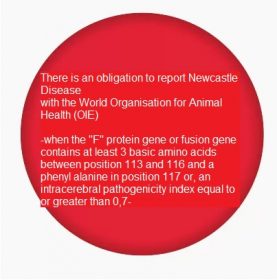
Broilers
In countries wherein ND is enzootic, in general at least one emulsion inactivated “dead” viral vaccine having added adjuvants and one or two applications of active “live” viral vaccines with lenthogenic strains are used in broilers.
Egg-laying
Immunization plans in egg-laying birds contemplate the use of 3 to 4 emulsion inactivated viral vaccines during production or breeding and multiple re-vaccinations with active virus during production and in the egg production cycle.
Despite these intense plans, the velogenic virus is still in the air. How can this be explained?

The main factors whereby this disease continues representing a constant challenge for our poultry industry are exposed below.
During 2004, there were losses in egg production in several companies which produced commercial egg in Mexico.
Losses were characterized in that they affected the external quality of the egg’s shell, generating mango-shaped eggs presenting around the egg-laying peak or after the birds were housed in the production barns.
The production drops could be from 8 to 30% and lasted from 6 to 9 weeks, and later, the birds recovered the production curve.
No important clinical sign was observed in birds (diarrhea, respiratory or nervous signs) and no virus could either be recovered when we processed samples for viral isolation in chicken embryo.
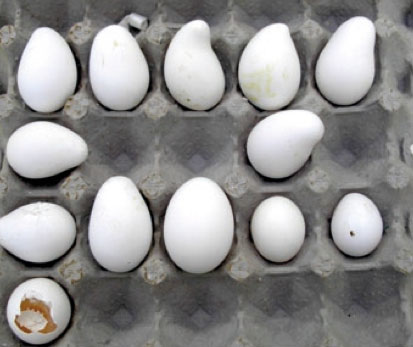
Figure 1. Eggs having the shape of a mango which are smaller and with less albumen quality appearing about the egg-laying peak in egg-laying birds affected by Newcastle Disease (ND)
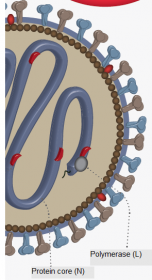
As part of the strategy for identifying the causes of the drops in egg production in the absence of clinical signs, specific pathogen-free birds were introduced in some companies as guard birds.
In a few days, mortality in these birds could be observed and also injuries which are typical of ND in its velogenic presentation were detected in the post mortem examination, and the ND virus in its velogenic form was isolated and characterized. In this way, we could understand that the ND virus was the hidden cause.

Prior serologic analysis did not allow us to observe any significant increase of antibodies to the virus after the field challenge since the technique commonly used in Mexico is the haemagglutination inhibition, the same that is run until 1:10240 dilution, the level commonly observed in birds receiving the already referred vaccination plans.
Therefore, we did not observe the increase in the antibody levels generated with the ND outbreaks.
In some situations, a form of presentation besides the drop in egg-laying observed in layer hens and heavy breeders is that after the latter suffered layer drops, the shell of the egg, the trays and the egg collection and transport equipment were contaminated with virus. In this manner, some chicks were contaminated in the hatchers, sporadic although acute outbreaks being observed at uncommonly very early ages in broilers.
Once the problem and its cause were identified, it was difficult to understand them since we could confirm that the losses in production even occurred in properly vaccinated and high antibody titer birds -prior literature published by Dr. Gregorio Rosales documented that mortality protection was obtained with levels of 32 or higher and protection from drops in egg-laying was obtained with levels of 128 or higher-.
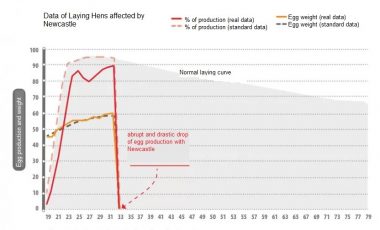
Weeks
Figure 1. Production graph of a batch of laying hens suffering from Newcastle.
Comparison of real data and standard values of ND. When there is Newcastle disease, egg production is drastically affected
ND viruses differ in their genome despite that all pertain to only one serotype according to Dr. Patti Miller
Fortunately, when these problems arose, we found the publication of a paper in the Meeting of American Avian Pathologists (AAAP), by a group of investigators of SERPL (Southeast Research Poultry Laboratory) from the United States Agriculture Department, being Dr. Patti Miller the one who stands out. She has documented that ND viruses may be molecularly classified for their genome differences even though all pertain to only one serotype.
This first published paper demonstrated the differences in the volume of viral excretion in birds vaccinated with inactivated vaccines emulsified and challenged with homologous and heterologous genotypes.
The arrival of Dr. Claudio Afonso to this team of investigators contributed very valuable information and investigation about this issue, with a new universal scheme being proposed by him in order to classify Newcastle viruses according to their genotype.
Today, the existence of 2 virus classes (1 and 2) of the Newcastle disease is determined, with those of class 2 being the important ones for commercial aviculture (class 1 is basically found in wild birds). Within this classification, the existence of 18 different genotypes for class 2 is determined.
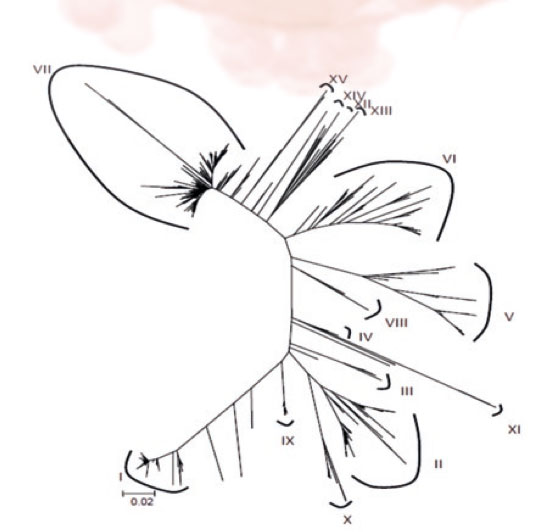
Figure 2. New universal scheme proposed by Dr. Claudio Afonso for classifying the Newcastle virus according to its genotype

Graph 1. Production data of a batch of layers suffering from Newcastle compared with standard data of Newcastle
As one would anticipate, this group of investigators could document that when there is higher similarity between the vaccine seed and the challenge virus, the amount of excreted virus after any challenge will be lower, and statistically significant differences exist between the amount of excreted virus -from 100 to nearly 1000 times lower amount of excreted virus when immunizing birds with virus homologous to the challenge virus-.
This same effect of viral excretion decrease associated to the use of emulsion inactivated vaccines of homologous genotype was observed in recombinant live vaccines.
Even further, it was documented that these differences are important for the transmission and horizontal dissemination of the virus.
It was also published that the field outbreaks nowadays differ from those which occurred 30 or 40 years ago. In those days, velogenic strains of genotypes I and II were detected.
Today, these strains, which circulated before in the industry have disappeared from the field and they are only preserved in our freezers as reference and challenge velogenic strains, such as strains Texas GB y Querétaro.
Genotypes which are present in the outbreaks recently registered in Latin America pertain to genotype V in Mexico and Central America, and to genotype VII in South America and the Caribbean region.
This is because ND virus populations have been suffering a genetic change process over time. Although at a much lower rate compared to other RNA viruses such as the Avian Influenza Virus, although, at the end of the day, they have changed.
When birds are immunized with virus homologous to the challenge virus, the amount of excreted virus decreases from 100 to nearly 1000 times
This is to be expected considering that the poultry industry has significantly evolved in the last 50 years and that its production systems and the population of birds in the field have intensely increased.
No changes have occurred in relation to vaccine virus strains which we use for its control and the majority of which consist of strains pertaining to genotypes I and II, including strains such as B1 La Sota y B1B1, both from genotype II and Ulster pertaining to genotype I.
Although 3 countries have developed vaccines with genotype homologous to ND virus (Mexico, Korea and China), there are some factors which do not contribute to the adoption of this strategy at the international level.
One of the factors is the fact that developed countries are free of this virus and when outbreaks appear, the control measure to be adopted is generally the slaughter of infected birds.
This is why these countries do not need to rely upon vaccine protection and there is no clear idea of the limitations of vaccines and vaccination strategies adopted for many years.
On the other hand, most countries having the enzootic presence of the disease are developing countries wherein investigation and technological development are emerging or limited.
Another aspect is that regulations for registering a vaccine against ND at international level only require that protection against mortality is documented, but its capacity to reduce viral excretion does not have to be documented.
A well-demonstrated and documented fact is that genotype II vaccines are capable of protecting against mortality in challenge tests with heterologous genotype virus as required by international health rules. However, it is clear that they do not protect against egg-laying drops and allow for replication and elimination of higher viral loads than vaccines with a homologous virus.
It was only possible to demonstrate that there are differences in the protection against mortality using models wherein the vaccine dose is only reduced and an early post vaccination challenge is carried out in works carried out by Stivalis García, in the laboratories of the United States Agriculture Department. Therefore, an imperative need of changing the strategy which has been employed with the use of vaccines of genotype II, is not perceived.
Much has been written and will continue to be written about factors influencing on the appearance of Newcastle outbreaks in the field, such as incorrect application of vaccines, poor biosecurity, live bird handling and transport and contaminated bedding, commercialization systems of birds and poultry products, immunodepression factors and others.
Use of poultry litter as agricultural fertilizer next to poultry sheds and the absence of adequate bedding treatments which eliminate the velogenic virus from this material are common routes for infectious material spreading.
Furthermore, the use of poultry litter for feeding cattle and its transport without any kind of effective treatment together represent a very important source of infection.
While all these issues are very important issues to be considered, they are not the main topic of this article.












